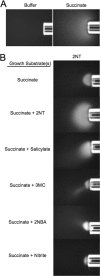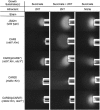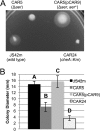Three types of taxis used in the response of Acidovorax sp. strain JS42 to 2-nitrotoluene
- PMID: 22286989
- PMCID: PMC3302635
- DOI: 10.1128/AEM.07183-11
Three types of taxis used in the response of Acidovorax sp. strain JS42 to 2-nitrotoluene
Abstract
Acidovorax sp. strain JS42 is able to utilize 2-nitrotoluene (2NT) as its sole carbon, nitrogen, and energy source. We report here that strain JS42 is chemotactic to 2NT and that the response is increased when cells are grown on compounds such as 2NT that are known to induce the first step of 2NT degradation. Assays with JS42 mutants unable to oxidize 2NT showed that the first step of 2NT metabolism was required for the induced response, but not for a portion of the constitutive response, indicating that 2NT itself is an attractant. The 2NT metabolite nitrite was shown to be a strong attractant for strain JS42, and sufficient nitrite was produced during the taxis assay to account for a large part of the induced response. A mutant with an inactivated ntdY gene, which is located adjacent to the 2NT degradation genes and codes for a putative methyl-accepting chemotaxis protein, showed a defect in taxis toward 2NT that may involve a reduced response to nitrite. Responses of a mutant defective for the energy-taxis receptor, Aer, indicated that a functional aer gene is required for a substantial part of the wild-type induced response to 2NT. In summary, strain JS42 utilizes three types of taxis to sense and respond to 2NT: constitutive 2NT-specific chemotaxis to directly sense 2NT, metabolism-dependent nitrite-specific chemotaxis that may be mediated by NtdY, and energy taxis mediated by Aer.
Figures







Similar articles
-
Selection for growth on 3-nitrotoluene by 2-nitrotoluene-utilizing Acidovorax sp. strain JS42 identifies nitroarene dioxygenases with altered specificities.Appl Environ Microbiol. 2015 Jan;81(1):309-19. doi: 10.1128/AEM.02772-14. Epub 2014 Oct 24. Appl Environ Microbiol. 2015. PMID: 25344236 Free PMC article.
-
Oxidative release of nitrite from 2-nitrotoluene by a three-component enzyme system from Pseudomonas sp. strain JS42.J Bacteriol. 1994 Dec;176(24):7462-7. doi: 10.1128/jb.176.24.7462-7467.1994. J Bacteriol. 1994. PMID: 8002568 Free PMC article.
-
Expression of the nitroarene dioxygenase genes in Comamonas sp. strain JS765 and Acidovorax sp. strain JS42 is induced by multiple aromatic compounds.J Bacteriol. 2003 Jul;185(13):3895-904. doi: 10.1128/JB.185.13.3895-3904.2003. J Bacteriol. 2003. PMID: 12813084 Free PMC article.
-
Bacterial energy taxis: a global strategy?Arch Microbiol. 2010 Jul;192(7):507-20. doi: 10.1007/s00203-010-0575-7. Epub 2010 Apr 22. Arch Microbiol. 2010. PMID: 20411245 Free PMC article. Review.
-
Microfluidic Devices Developed for and Inspired by Thermotaxis and Chemotaxis.Micromachines (Basel). 2018 Mar 26;9(4):149. doi: 10.3390/mi9040149. Micromachines (Basel). 2018. PMID: 30424083 Free PMC article. Review.
Cited by
-
Functional Annotation of Bacterial Signal Transduction Systems: Progress and Challenges.Int J Mol Sci. 2018 Nov 26;19(12):3755. doi: 10.3390/ijms19123755. Int J Mol Sci. 2018. PMID: 30486299 Free PMC article. Review.
-
Pseudomonas putida F1 uses energy taxis to sense hydroxycinnamic acids.Microbiology (Reading). 2017 Oct;163(10):1490-1501. doi: 10.1099/mic.0.000533. Epub 2017 Sep 28. Microbiology (Reading). 2017. PMID: 28954643 Free PMC article.
-
Chemotactic response of p-nitrophenol degrading Pseudomonas asiatica strain PNPG3 through phenotypic and genome sequence-based in silico studies.3 Biotech. 2023 Dec;13(12):408. doi: 10.1007/s13205-023-03809-3. Epub 2023 Nov 18. 3 Biotech. 2023. PMID: 37987023 Free PMC article.
-
Chemotaxis Towards Aromatic Compounds: Insights from Comamonas testosteroni.Int J Mol Sci. 2019 Jun 1;20(11):2701. doi: 10.3390/ijms20112701. Int J Mol Sci. 2019. PMID: 31159416 Free PMC article. Review.
-
Selection for growth on 3-nitrotoluene by 2-nitrotoluene-utilizing Acidovorax sp. strain JS42 identifies nitroarene dioxygenases with altered specificities.Appl Environ Microbiol. 2015 Jan;81(1):309-19. doi: 10.1128/AEM.02772-14. Epub 2014 Oct 24. Appl Environ Microbiol. 2015. PMID: 25344236 Free PMC article.
References
-
- Adler J. 1973. A method for measuring chemotaxis and use of the method to determine optimum conditions for chemotaxis by Escherichia coli. J. Gen. Microbiol. 74: 77–91 - PubMed
-
- Alexandre G. 2010. Coupling metabolism and chemotaxis-dependent behaviours by energy taxis receptors. Microbiology 156: 2283–2293 - PubMed
-
- Anantharaman V, Aravind L. 2000. Cache—a signaling domain common to animal Ca2+ channel subunits and a class of prokaryotic chemotaxis receptors. Trends Biochem. Sci. 25: 535–537 - PubMed
Publication types
MeSH terms
Substances
LinkOut - more resources
Full Text Sources

